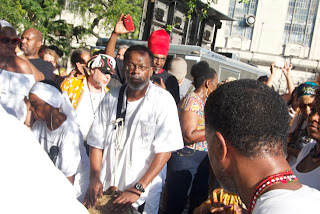December, 2013
Fulfilling the rhythmic, melodic and harmonic function, Modern Jazz Bassist, James Singleton and his quartet rocked New Orleans' own Cafe Istanbul in November and December 2013.
Mike Dillon, Larry Sieberth, and Tim Green complete the quartet. Together they all served up a big steaming bowl of New Orleans gumbo with a twist of the revolutionary avant-garde. These jazz veterans are New Orleans' mainstays.
Each show amounted to a couple of hours of intelligent groove informed by jazz but rarely beholding to it. With improvisation as a blinding non-idiomatic force, the performances were impressively done with great continuity. This important avant-garde blend of jazz proves that this quartet thrives on high velocity.
Singleton is a composer and a bandleader. This New Orleans preeminent modern jazz artist has worked with a wide array of musicians. The short list include: Professor Longhair, Aarron Neville, Joe Henderson, Milt Jackson, Clark Terry, Ellis, Branford, Wynton, and Jason Marsailis, Natalie Cole, Eddie Harris, John Schofield, Charlie Rich, Lars Edegran, Teddy Riley, the Wild Magnolias and the short list gets longer.
Picture Singleton in the driver's seat improvising on bass, simulating unique genius, and getting his dance groove on with his instrument like a dance partner. Add to the mix, his playing a tiny trumpet. It's like nothing you've ever seen before.
Singleton's base provides the bottom and the pulse. It probes and prods working in tandem and in team with drummer/vibraphonist, Mike Dillon's rhythmic decorative embellishment of harmonic and melodic material to the other players. Singleton further grounds and guides a performance of improvisational music, leaving plenty of room for each player as he deploys his forces ingeniously.
Few musicians combine the chops and vision of Mike Dillon, a percussionist, vibraphonist, and bandleader in his own right. Having been on the New Orleans scene for many years, his sound is intense. With attitude taken from punk rock with a slightly dirty loud found in rock 'n' roll, he'll slip in a little Lionel Hampton as a side dish. This deceptive complexity makes you want to shake that booty, but then changes textures at the drop of a dime.
Playing as unit of all-stars, the music is very free structurally. Singleton leaves plenty of room for each player to "throw down" hard and heavy. His bow takes an audience into a profound abyss of blending his harmonics with the overtones provided by Larry Sieberth's piano, creating a bridge into the spiritual world.
Hunched over the piano in a "Schroeder" - like manner (the fictional character in the comic strip Peanuts, created by Charles M. Schultz), Sieberth uses his mystical powers to make the piano "talk" in many languages. Ace sideman on the New Orleans modern jazz scene, Siebert, is grounded in the traditional jazz canon. While Sieberth plays piano in the spirit and tradition of New Orleans, his influences are not necessarily the usual New Orleans influences.
On stage Sieberth reveals something entirely different by taking his audiences on a journey beyond entertainment by surprisingly expanding your perception of what New Orleans music is and has the potential to be. According to Tim Green, the quartet's saxophonist, "He's a wizard."
As pianist, composer, arranger, musical director, educator and producer, Sieberth has collaborated with musicians on the international scene. Honored as an outstanding jazz pianist by New Orleans Magazine, his soundtracks for television, film and stage have earned him numerous awards, including a "Telly".
Tim Green serves up a high level of improvisation on saxophone in a powerful language that heats up the jazz renaissance reminding us of where jazz has been, where it is, and where it is going. According to Singleton, "Tim's alto saxophone brings it all home for us."
Green has fond memories of playing the "Bay Area Jazz Scene." Having played "The Boom Boom Room" many times, Green is smitten by the music of Latin Jazz artist Marquez of Oakland.
Green credits the senior music students at Berkelee during the time of his stint of formal jazz education there. "The institutionalized jazz during my time was not necessarily the place for me. I'd listen to the best players there, and take notes from their playing," said Green.
The saxophonist extraordinaire has a deep linguistic conversationalist playing style that goes over big on stages for live audiences where the musical "moment" happens. Some of his best work is there. "We're so spoiled here in New Orleans with music all over the place," shouted a woman from the audience, "I heard Tim Green play earlier today at another show." A saxophonist of vision and self-assurance, Green has worked extensively on the New Orleans jazz scene.
Although based here in New Orleans, this preeminent team of musicians are not strangers to "The Bay Area." Jamming on the jazz scene at Yoshi's Oakland, in San Francisco at the Fillmore, and The Boom Boom Room in their own individual bands is a common occurrence. "I just performed at The Boom Boom Rom in San Francisco with "my" band last week," said, drummer Mike Dillon.
At the end of the show, Singleton said, "Tonight was one of those nights where everything came together." According to Green, "This is more fun for me than anything. People beyond New Orleans need to hear what we're playing."
























































